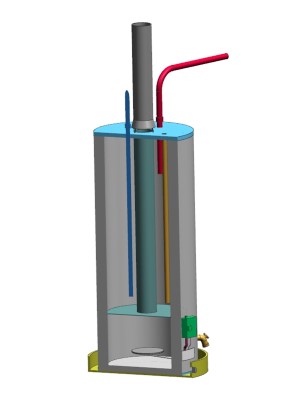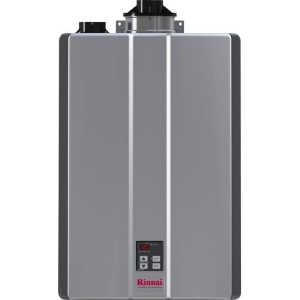Tips on Installing a Draft Hood on Gas Water Tank Heaters
What is the draft hood, how does it work, instructions on how to install it on the atmospheric-vent gas water heater, problems you can expect, and solutions.
What do you need to know about atmospheric-vent water heaters?

All water heaters powered by natural gas or propane require a venting system - to remove the exhaust gases out, including the dangerous carbon monoxide.
The simplest and most affordable type of all gas water heaters is the atmospheric type.
Atmospheric-vent water heaters use a metal pipe and chimney and are often terminated on the roof, transferring products of combustion (flue gases) to the outdoors. It doesn't use the electric blower as the power vent, but the natural convection.
It is vital to provide a vertical or upward sloping vent during the installation so the hot fumes can rise quickly to the outside atmosphere. To ensure efficient draw an upward gas flow, it is essential to have the required height of the vertical section so as the temperature of the exhaust gases.
Things to know when installing a draft hood

Every gas water heater with the atmospheric venting system is equipped with a draft hood, located at the top of the heater and connecting a heater with the venting system.
The draft hood is designed to cool the products of combustion and transfer them safely from the combustion chamber to the venting system and out. It also protects the heating operation during updrafts and downdrafts caused by indoor and outdoor air pressure differences.
On the top of the draft hood goes the metal flue exhaust. Depending on the model, the draft hood accommodates 3" or 4" vents or both sizes and is designed for single or double-wall vent (galvanized) pipes.
In the case of the double-wall vent pipe, the recommendation is to install the Type B draft hood connector. A vent pipe connector should also be used if the vent pipe has a larger diameter than the draft hood.
- Find Plumbers In Your Area -
Draft hood types and installation tips
A gas water heater can use one of the two draft hood types: lock-in or push-in type. Both types are easy to install; the first one uses the slots so the draft hood legs can be securely locked in, while the other one is secured with the self-drilling screws (usually provided). If the screws are not provided, the recommendation is to use 5/8" long screws or shorter. Three screws, evenly spaced out, work the best.
While installing the vent pipe over the draft hood, you must secure the connection with the sheet metal screw. The size of the vent pipe must not be smaller than the draft hood, and the connection must be airtight to prevent the leak of the flue gases. Some adjustments might be needed as long as the original size and shape are kept.
The draft hood installation must be done per manufacturer instructions and codes.
How to test the draft hood for the proper operation
To test the draft hood for the proper operation, it is recommended to depressurize the house. Close all the doors and windows and let all the fans inside the house working (clothes dryer, range hood, bathroom fans, and others).
Take the match and lit. Hold it close to the draft hood. If the match flame/smoke gets into the draft hood, the venting is operating as it should. You can also use a glass or mirror, and if it gets fogged up, the flue gases are escaping the venting system and are going into the house – not good.
Potential problems
One of the most common issues due to the improperly designed and installed vents is backdrafting. Backdrafting is a result of the insufficient draft, so gases are coming back into the house. An excessive draft is also a problem as it can lead to higher than normal noise, sooting and poor burner performance.
In addition to venting the flue gases, every gas water heater installed in a confined space needs an air supply for the proper gas combustion. Combustion and ventilation air could be supplied from inside or outside the house.
It is recommended to have a professional plumber install the water heater and venting, following the manufacturer's instructions and building codes.
Do's and don'ts
- Don't use the draft hood from the old heater or a different model. Each model is supplied with a specific draft hood.
- Don't modify, cut or change its original shape during the installation.
- Don't block the draft hood and area around.
- Don't place any object in the proximity of the draft hood.
- Don't install any other vent type, except recommended.
- Don't use any other material of the vent except recommended. A vent pipe should be made of galvanized steel.
Required and optional tools and materials
- Pliers
- Drill
- Screwdriver
- Tape measure
- Cutting tool for sheet metal



